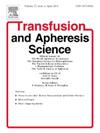The 2024 international survey of platelet products and practice
IF 1.4
4区 医学
Q4 HEMATOLOGY
引用次数: 0
Abstract
Background
Previously, two international surveys have addressed the wider application of platelet collection by apheresis technology and practical issues of platelet transfusion.
Study design and methods
A questionnaire was sent to persons with leadership roles related to blood banking and transfusion medicine in their countries/areas/centers, to document the implementation of modern technologies for platelet manufacturing, preservation, and transfusion risk reduction.
Results
Responses to the questionnaire finally came from 52 contributors in 40 countries/areas. Adult platelet doses ranged between 2.0×1011 and 4.0×1011 (median 2.5×1011). In approximately 10 % of centers, apheresis platelets comprised more than 90 % of the platelet inventory. More than 70 % of centers adopted universal or near universal leukocyte-reduction by filtration, apheresis, or both. Almost 20 % of centers irradiated all platelet products. Cold-stored platelets were rarely reported; only 3 centers produce such components for 1 % to 5 % of their supply. The use of platelet additive solution was reported by 18 responders (45 %), mainly in Europe, USA, and Australasia. Bacterial detection systems were reported by 18 responders from around the globe. One fatality was reported after transfusion of a platelet product contaminated with Bacillus cereus, whereas no sequelae were observed after transfusion of >350 platelet products contaminated by Cutibacteriae. Pathogen-reduction/pathogen-inactivation technology has been adopted in 15 centers, with little or no extended expiration period. Export of platelets across national borders was extremely rare.
Conclusion
With this addition to the literature on platelet transfusion, considerable heterogeneity in collection, processing, and transfusion can be seen across the globe, through which readers may adopt, and adapt, best practices for their unique local circumstances.
2024年国际血小板产品调查与实践
此前,两项国际调查已经解决了血小板采集技术的广泛应用和血小板输注的实际问题。研究设计与方法向所在国家/地区/中心血库和输血医学相关领导人员发放问卷,记录现代血小板制造、保存和降低输血风险技术的实施情况。最终问卷的回复来自40个国家/地区的52位贡献者。成人血小板剂量范围为2.0×1011和4.0×1011(中位2.5×1011)。在大约10% %的中心,单采血小板占血小板库存的90% %以上。超过70 %的中心通过过滤、分离或两者同时采用普遍或接近普遍的白细胞减少。几乎20% %的中心辐照所有血小板产品。冷藏血小板很少被报道;只有3家中心生产这种组件,占其供应量的1% %到5% %。18名应答者(45% %)报告使用血小板添加剂溶液,主要在欧洲、美国和澳大利亚。来自全球各地的18名应答者报告了细菌检测系统。在输注被蜡样芽孢杆菌污染的血小板产品后报告了一例死亡,而输注被cutibacterae污染的350例血小板产品后未观察到任何后遗症。15个中心采用了病原体还原/灭活技术,很少或没有延长有效期。跨国出口血小板极为罕见。有了这些关于血小板输注的文献,可以看到全球各地在收集、处理和输注方面存在相当大的异质性,读者可以根据自己独特的当地情况采用和调整最佳做法。
本文章由计算机程序翻译,如有差异,请以英文原文为准。
求助全文
约1分钟内获得全文
求助全文
来源期刊
CiteScore
3.60
自引率
5.30%
发文量
181
审稿时长
42 days
期刊介绍:
Transfusion and Apheresis Science brings comprehensive and up-to-date information to physicians and health care professionals involved in the rapidly changing fields of transfusion medicine, hemostasis and apheresis. The journal presents original articles relating to scientific and clinical studies in the areas of immunohematology, transfusion practice, bleeding and thrombotic disorders and both therapeutic and donor apheresis including hematopoietic stem cells. Topics covered include the collection and processing of blood, compatibility testing and guidelines for the use of blood products, as well as screening for and transmission of blood-borne diseases. All areas of apheresis - therapeutic and collection - are also addressed. We would like to specifically encourage allied health professionals in this area to submit manuscripts that relate to improved patient and donor care, technical aspects and educational issues.
Transfusion and Apheresis Science features a "Theme" section which includes, in each issue, a group of papers designed to review a specific topic of current importance in transfusion and hemostasis for the discussion of topical issues specific to apheresis and focuses on the operators'' viewpoint. Another section is "What''s Happening" which provides informal reporting of activities in the field. In addition, brief case reports and Letters to the Editor, as well as reviews of meetings and events of general interest, and a listing of recent patents make the journal a complete source of information for practitioners of transfusion, hemostasis and apheresis science. Immediate dissemination of important information is ensured by the commitment of Transfusion and Apheresis Science to rapid publication of both symposia and submitted papers.

 求助内容:
求助内容: 应助结果提醒方式:
应助结果提醒方式:


